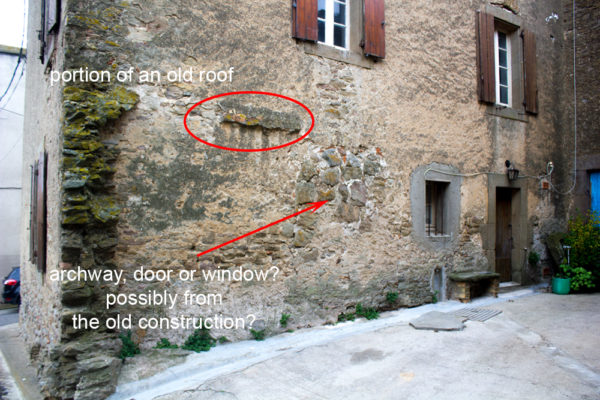Whilst in the graveyard today, there was a man tending a grave. It was his father’s grave, a man that had grown up in the village. A typical local. A vigneron (person that work on the vines) overalls, beret, southern accent.
I got chatting to him, and he was just full of information about the old house. And very open too.
He remembers the old lady there, Louise Pagès. She used to come out to the front of the house smoking a long cigarette. She had a live-in housekeeper.
He remembers after she died, the new owners, the Doutres moving in. She was very huffy, yet he was very reserved and quiet. According to him, they were the ones that laid those revolting ceramic floor tiles in the dining room, hallway and kitchen. He told me he remembers when they did it – and he knows the company that did all the work. They came from Laure-Minervois, the next village.
What he told me next literally stunned me….
I was dying to ask him if he had ever been into the house, the dining room side? No need to have asked, as he described it perfectly. He had visited when old lady Pagès lived there.
He explained that the Doutres had called in the workmen to get rid of the floor and they had dug up and taken away tonnes of old ‘dalles’ (ancient flagstone paviors) before relaying a modern screed and finishing it with those grotty tiles. I asked what they had done with those dalles – he rubbed his fingers together meaning they had resold them later. They were worth some money he said.
No bloody kidding they were.
So my idea of the ground floor having a wooden surface originally, has been disproved. At least thats true for the right-hand-side of the ground floor. It was done in ‘bluestone’ flags and they were only replaced 40 years ago. The sole clue as to what they looked like is probably the first step on the stairs, which is still in its place. Damaged but still there. Obviously these guys didn’t fancy taking that out too and left it. The LH side always had parquet in it as far as he remembers.
This brings me onto one of my hypotheses about the construction of the house.
On the outside of the gable wall that overlooks the fountain, there is an anomaly.
Here it is

Its directly behind where the big chimney used to be in the Dining room. From the outside you can see it starts about 50cms above the road level, (which is floor level inside the house), then two straight vertical lines rise to a height 2m above that where there are two broken roof tiles embedded in the wall. These lines are exactly 2m apart. They might rise further still but the old render is covering it so I can’t be sure.
It basically looks like there used to be an opening in the wall there, and its been blocked back up. The strange thing is, is that all the stone used to block it up matches perfectly with the surrounding stone, which leads one to believe it wasn’t filled in later on down the line, but whilst the house was being built??
My idea was that (although I have no plan of the village in 1749 – its been lost) I think there may have already been a house on the site back then. The quoin stones on the front right of the house have always just stood out from the rest as having some real age.

Click here for the Pottery shard blog
I think the bottom part of this wall, from front right to back right was a wall in the first house, that they partly demolished and then reused the stones to build some of the big house. The new entrance was around the front now, so the opening was filled in with some of the demolished stone. Maybe this explains why the stone infill is the same.
Another clue is the weird way the fountain gable wall finishes at the courtyard. It doesn’t have nice quoins like the front of the house, it just sort of feathers out a bit further into the courtyard – a bit like a buttress for a building.


I think the first house was a bit longer than the wall is now and they didnt demolish the whole thing but kept what was good and solid.
And the third and most important clue is the blocked-up doorway in the courtyard wall. That was never a doorway into the new house as all the new openings had stonework surrounds. I reckon this was the back door in the old house.

If the R/H side of the new house was about the whole of the old one, then those flagstones were almost definitely from the original construction, maybe from the early 1600’s.
No wonder they took them up to resell them.
If all this seems sheer hypothesis, then it is. There are some compelling arguments for the theory, but I have one clue left that can prove 95% there was an old house there before mine.
